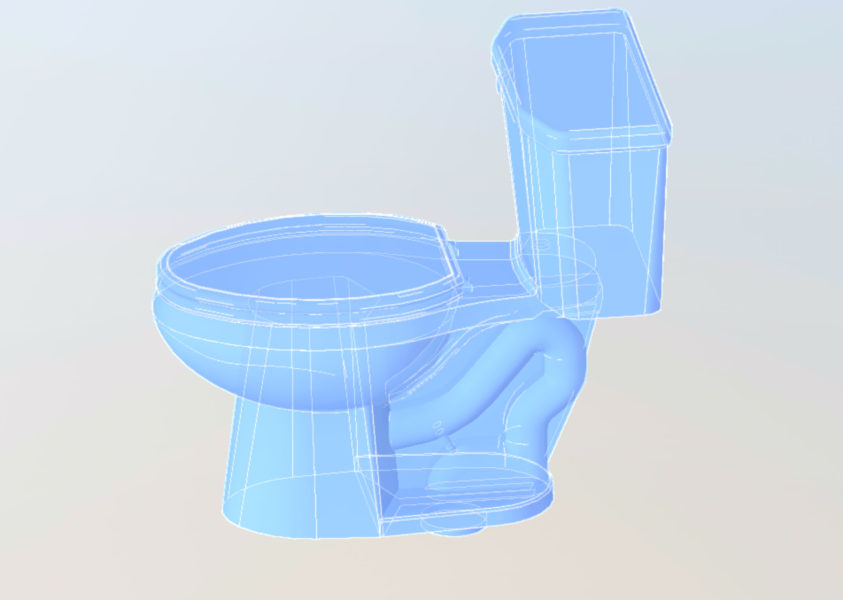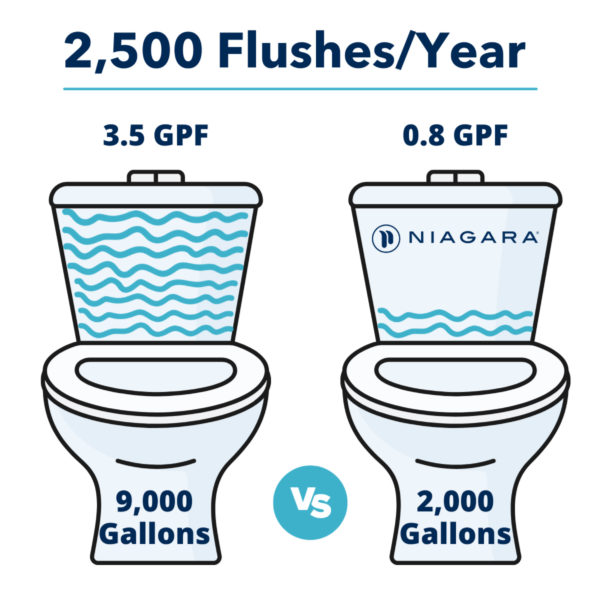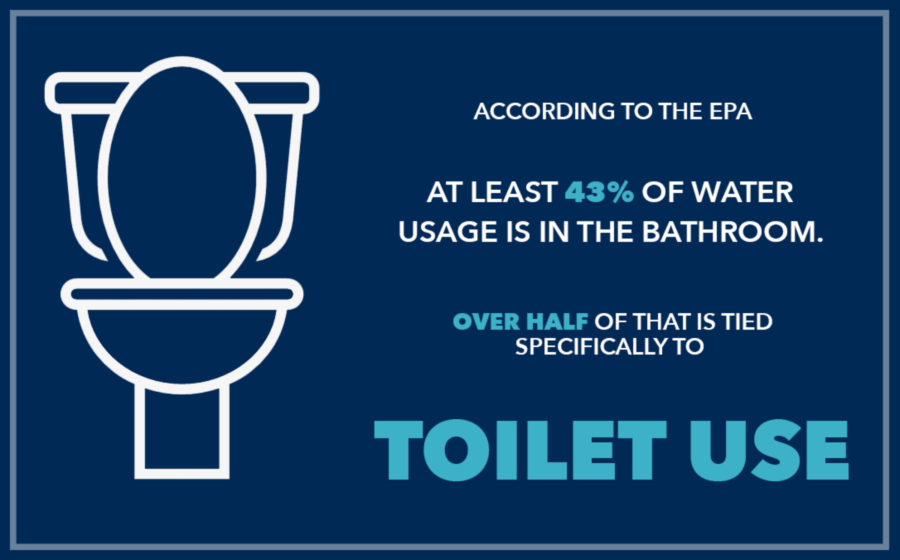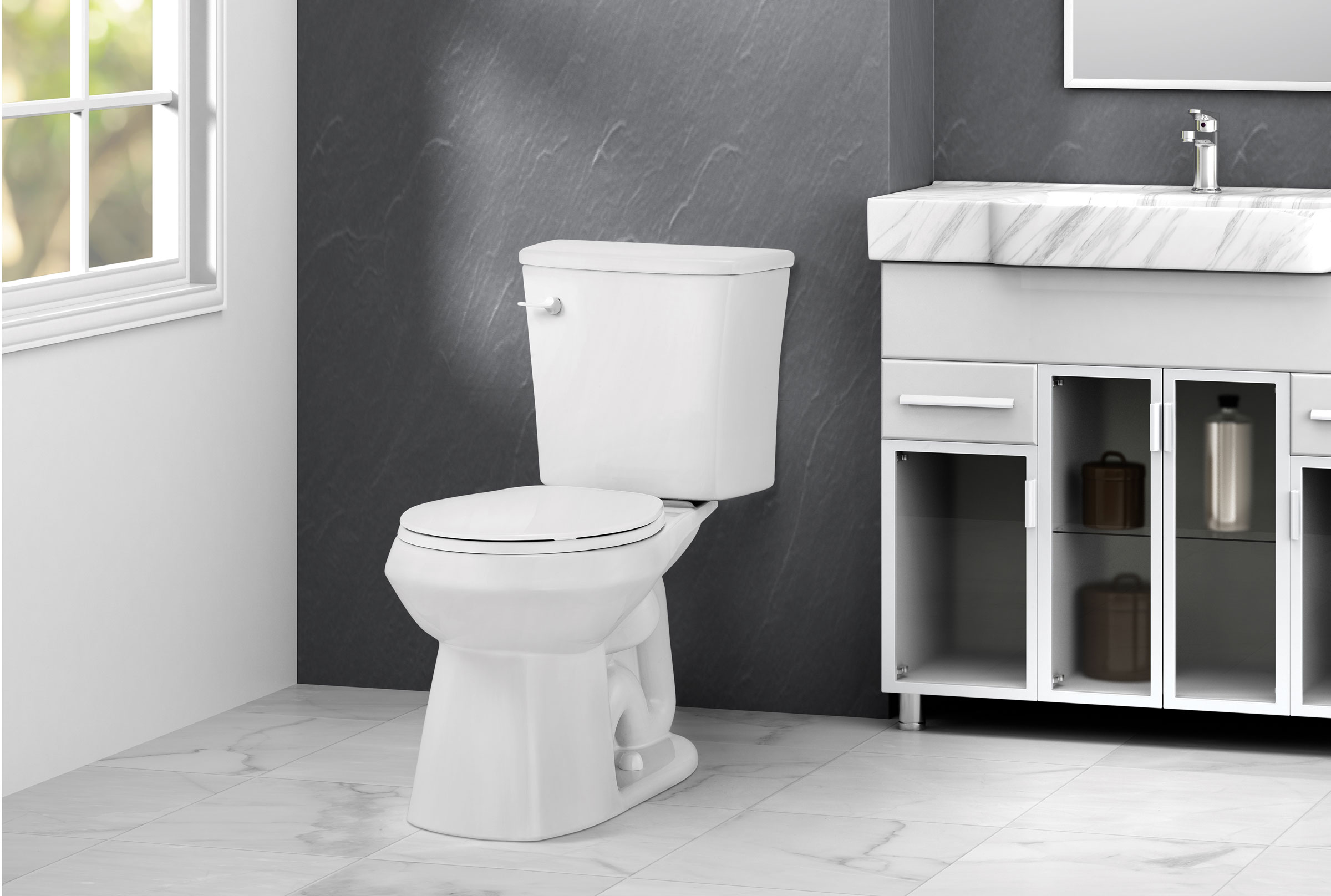Story at a glance:
- Water conservation can help buildings earn LEED points.
- The average toilet uses 7,500 gallons per person, per year.
- Using high-efficiency toilets is an easy way to implement water conservation.
With the introduction of Covid-19 and the global lockdowns that ensued, the impact we have on our environment became obvious. Whales returned to New York City’s harbor, the Himalayas were visible from Punjab for the first time in decades, and CO2 levels fell dramatically across the globe. These, among other things, encouraged companies to start taking on the responsibility for their carbon footprints and publicly proclaim how they are working to be environmentally responsible.
Architectural firms have the unique opportunity to make a large impact on a company’s carbon footprint. Architects are the spearheads of new construction and retrofitting existing spaces, so it is now a responsibility for firms to utilize the resources available to them to create buildings that have the smallest carbon footprint possible. One way to ensure this is by implementing a sustainability plan.
By implementing a sustainability plan in your firm’s best practices, you will be doing your part to not only help the world but maintain growing standards being set by the governing bodies to maintain resource management and high goals like the 2030 Carbon Neutral Challenge or even just LEED requirements.
What is a sustainability plan and why do you need it?

Image courtesy of Niagara
Sustainable building design is the practice of creating structures and using processes that are environmentally responsible and resource-efficient throughout the life cycle of a building—from selecting the site to design, construction, operation, maintenance, renovation, and finally, deconstruction.
Now, a sustainability plan is what makes building design and construction feasible and provides the benchmarks against which building plans should be tested. The EPA states that green buildings are designed to reduce the overall impact of the built environment on human health and the natural environment. Green buildings can accomplish this by efficiently using energy, water, and other resources, protecting occupant health, improving employee productivity, and by reducing waste, pollution, and environmental degradation.
Additionally, the National Institute of Building Sciences defines six fundamental principles of sustainable building:
1. Optimize site potential
2. Optimize energy use
3. Protect and conserve water
4. Optimize building space and material use
5. Enhance indoor environmental quality (IEQ)
6. Optimize operational and maintenance practices
Although it seems like a lot to consider, we know that your firm is detail-driven and understands these principles. What your firm may not consider is that by focusing on water conservation as a top priority, all six principles will be covered.
Why you should focus on water conservation in your sustainability plan.
Water is quickly becoming one of the most expensive and depleting resources. The 2021 US Municipal Water and Wastewater Utility Rate Index showed that the combined water and wastewater bill has increased by 43.2% since 2012. In the past decade, there have been record-breaking droughts and we have seen an alarmingly fast depletion of water resources.
It seems like every day there’s a new report coming out showing Lake Mead at record lows and it doesn’t look like there will be a reprieve any time soon. This has led to increasing water and sewer rates, as well as water use restrictions on the state and federal levels.
In Maslow’s hierarchy of needs, water is a physiological base that needs to be met for us to reach additional, higher needs like deep thought or growth. This is very similar to a plan for a sustainable building: water conservation is a foundational block for reaching a net-zero building. When water conservation is being thought of first, the rest of the six principles fall into line.
How to meet water conservation needs for sustainable planning.

Image courtesy of Niagara
From utilizing greywater systems to planting native plants in the landscaping there are many ways to meet the requirements that buildings need to be considered water-conserving. However, we have found that the best way to conserve water is to pay attention to how your tenant will be using water in your space—specifically how they will be utilizing the bathrooms. According to the EPA, at least 43% of water usage is in the bathroom—over half of that is tied specifically to toilet use.
For example, the average adult uses a toilet 2,500 times a year. Every flush can use up to 3 gallons of water depending on the model of toilet that was specified for the space. That’s over 7,500 gallons of water, per person, per year. For a building that hosts dozens or even hundreds of people, before counting visitors to the building, the waste can add up quickly. Additionally, if you typically specify hand-free flushing tools, the energy use and errors caused by these sensors can cause twice as many flushes to happen. If you want to get specific about a building you’re currently specifying, the International Association of Plumbing and Mechanical Officials has released a tool called the Water Demand Calculator which modernizes the calculation method of water supply pipe sizing.
Most of the waste mentioned above can be avoided by getting creative with specifying high-efficiency toilets like Niagara’s models. Here are some components to consider when wondering how to choose a high-efficient toilet:
- Make sure it’s EPA WaterSense certified.
- Be sure that the flush technology matches the property type.
- Ensure that it’s MaP certified for flush performance.
- Ensure an IAPMO rating of 40ft or more in drain-line carry.
- Make sure there’s a warranty of at least 15 years.
Not all high-efficiency toilets will work for your property type. We recommend using a higher volume flush for taller buildings to help push waste down the drain line, and utilizing a pressure-assist model, like our Barron, for buildings with higher amounts of traffic. But there are ways to still specify high-efficiency models.
For example, if you want to use a high-efficiency model like Niagara’s Shadow 0.8 GPF, simply put a higher volume model like the Shadow 1.28 GPF at the top of the drain line to help move the rest of the building’s waste through. This way, only one toilet has a higher chance of water waste while the rest of the building is operating at a low-waste capacity. Additionally, if you utilize newer flush technology like Stealth® technology, which has a vacuum-assisted flush, you can be satisfied that 0.8 GPF will get the job done every time.
Vacuum-assisted flushes that use Stealth technology work by using an air transfer tube instead of a flapper—which is prone to breaks and leaks. When water fills the tank/inner chamber, the air is pushed back into the air transfer tube. This pressurizes the trapway and primes the toilet for a powerful, quiet flush. When the flush button is pressed, water leaves the Stealth inner chamber and pulls air from the trapway up through the air transfer tube. This creates a vacuum-assisted pull that accelerates the force of the water and waste flowing through the trapway.
No matter if you specify a toilet with a traditional flapper, a vacuum-assisted flush, or a pressurized vessel, be sure that the manufacturer you’re purchasing from offers a variety of flush volumes to fit the needs at the property you’re planning for. You may be halfway through planning for a property and find that you need a 1.28 GPF instead of a 0.8 GPF, or potentially a 1.1 GPF. This way it’s a simpler switch and you don’t have to go hunting for a new manufacturer to find the type of model you need.
Other ways to plan for sustainability through water conservation

Toilets aren’t the only fixtures that use a lot of water. If you’re planning for a residential, multifamily, hospitality, or a mix of some kind, you’re going to also have to account for shower heads and sink faucets. The average faucet flows at about 2.2 gallons per minute. If you wash your hands for 20 seconds, you will use close to three-quarters of a gallon. A low-flow aerator will slow down the flow to 1.5 gallons per minute or less—saving nearly 700 gallons of water each year.
Luckily manufacturers like Niagara have already done the heavy lifting and have a variety of options for high-efficiency, low water waste products that deliver the same performance as their wasteful counterparts.
If you’re mainly working on buildings that don’t have full bathrooms, you’ll want to consider adding some of the following tips to your sustainability plan:
- Use non-potable, site-recycled water for the cooling tower makeup, or use non-evaporative condenser heat rejection equipment. Choose either air-cooled or ground-sourced equipment based on the geographical location.
- Specify native plants that are tolerant of the property’s local climate, soil, and water conditions. These will rely more on rainwater and the typical climate to maintain, which also helps aid to optimize operational and maintenance practices.
- Specify drip irrigation systems and high-efficiency irrigation control via moisture sensors, or weather-based controllers. This help keep systems like sprinklers from going off at timed intervals when there has been recent rain.
- Implement appropriate safe strategies into your plans to recycle site wastewater like gray water or condensate, or municipal secondary treated water for irrigation, sewage conveyance, and toilet flushing.
- Collect stormwater runoff from the roof of the property, and site for irrigation, sewage conveyance, toilet flushing, and/or HVAC/process makeup water. It can also be recharged into an aquifer and then reused elsewhere.
- Specify tankless water heaters. Water heating can account for as much as 40% of energy use at a property. Tankless water heaters use less water and less energy, providing even more conservation.
By working all of these into your sustainability plan and specifying high-performing bathroom fixtures as a best practice, you’re not only going to cover all of the six principles, but you will also ensure that the property you’re building will qualify for various building certifications. Certifications like the USGBC’s LEED rating system, the WELL Health-Safety Rating, or Fitwel can lead to greater tenant confidence and trust, more efficient and cost-effective building systems, reduced water consumption, and an overall healthier office environment.
These programs don’t only help your customers; by planning for certifications like LEED, your firm is opening up the potential to receive building grants and government help thanks to the new infrastructure bill that was signed into action in 2021. Just by specifying high-efficiency products, you can easily earn LEED points. Niagara’s ultra-high-efficiency models alone have helped earn up to two LEED points for properties built in recent years. This will help move both your and your client’s bottom line and not only save money in the long run for them, but make your firm more money in the now.
Key Takeaways
Now that you know the best ways to frame your sustainability plan using water conservation strategies, you can now start building your sustainability plan or reworking your existing plan to utilize the tactics discussed in this article. Ensure that whichever manufacturer provides digital specification sheets and easy access to Revit files to make building your plans even easier. For example, Niagara uses BIM object to host all Revit files for their newest family of toilet lines and sinks.
Don’t lose projects to other firms because you don’t have a solid sustainability plan that includes accounting for the most valuable resource on earth—water.


